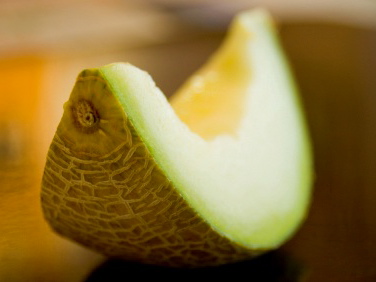
reference-image, l
(post, Sophia Markoulakis)
[%pageBreakSettings nobreak=true] We Greeks love our summer melon — especially right after a meal, before coffee and dessert. Growing up, we couldn’t leave the table until we had eaten our melon or other seasonal fruit that was meticulously carved by my dad. [[block(sidebar). h1.Featured recipes]] Maybe it was his way of getting us to eat more fruit. Maybe it was his way of spending more time with us. Or maybe it was his way of making my brother and me spend more time together. Melons are thought to have originated in Asia Minor, so they didn’t have to travel far to make their way to Greece. For centuries, the ancient Egyptians, Greeks, and Romans cultivated these members of the Cucumis family. Melons, squash, pumpkins, watermelon, and cucumbers fall into this large genus, and the resemblance is obvious. Several species of Cucumis exist, including muskmelons such as honeydew and our version of cantaloupe. (True European cantaloupe is aptly named after the town Cantalopo in Italy and can be hard to find Stateside. It’s related to the muskmelon and has similar flesh, but its skin is light green and ribbed, not netted and brown.) [%image reference-image float=right width=400 caption="A slice of fresh summer muskmelon."] Melon season begins in June and lasts through the summer. The sun is a melon’s best friend; without extreme seasonal heat, these aromatic fruit bombs would simply wither on the vine. When ripe, cantaloupes “slip” from the vine and shouldn’t have a stem attached. But honeydews continue to ripen when picked, can have a stem attached, and can be stored a bit longer than cantaloupes. Avoid melons that slosh when shaken or have any soft spots or bruising. Honeydew melons don’t give off an odor when ripe; this absence of fragrance is reflected in the fruit’s other name, Inodorus. A good way to determine a honeydew melon’s ripeness is to feel its skin. It shouldn’t feel slick and might have brown “freckles” on its surface. These freckles and the slight stickiness to its golden-green skin indicate ripeness. It’s much easier to determine if a cantaloupe is ripe. These netted melons give off an unmistakable sweet, musky fragrance. Their stem end will also give a little when pressed. Ripe melon is intensely sweet and pairs well with other strongly flavored foods, such as hard and brined European cheeses, cured meats, and herbaceous plants. Dried ancho chile gives sweet cantaloupe a kick in Cantaloupe and Spinach Salad with Ancho Chile-Lime Vinaigrette. And the grilling process in Grilled Pork, Honeydew, and Fig Skewers brings out the natural sugars in all three ingredients, creating a perfect balance of flavors. This time of year, with melons at their peak, experiment and have fun trying new flavor combinations. But you can still serve it the Greek way, lingering around the table with family and friends. p(bio). Sophia Markoulakis is a food and garden writer and recipe developer. She lives in the San Francisco Bay Area.

reference-image, l